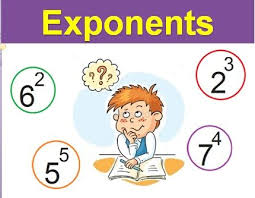In exponents we will mainly learn about the exponential form and product form, negative integral exponents, positive and negative rational exponents, laws of exponents etc,. To write large numbers in shorter form, so that it becomes very convenient to read, understand and compare, we use exponents. In exponents we will learn more about exponents and their uses.
When a number is multiplied with itself a number of times, then it can be expressed as a number raised to the power of a natural number, equal to the number of times the number is multiplied with itself.
3 × 3 × 3 × 3 × 3 can be written as 3⁵ and is read as 3 raised to the power 5. Here the base is 3 and the exponent is 5.
(i) (-2)⁴ = -2 × -2 × -2 × -2
(ii) (-2)³ = -2 × -2 × -2
aⁿ is called the nth power of a and can be read as:
a raised to the power n.
The rational number a is called the base and n is called the exponent or the power or the index.
Examples on exponential form;
(i) We can write -5 × -5 × -5 × -5 in the exponential form as (-5)⁴ and is read as -5 raised to the power 4. Here, (-5) is the base.
(ii) Also, 3/2 × 3/2 × 3/2 × 3/2 × 3/2 in the exponential form is written as (3/2)⁵ and is read as 3/2 raised to the power 5. Here, 3/2 is the base, 5 is the exponent.
Examples on product form;
(i) We can write 5³ in the product form as 5 × 5 × 5
and its product as 125.
(ii) Similarly, (-4/3)² is written as -4/3 × -4/3 and its product is 16/9.
Powers with positive and negative exponents such as 5² or (-5)² is the positive exponent and 5 or (-5) is the negative exponent.
Powers with Positive Exponents
10 = 1
10¹ = 10
10³ = 10 × 10 = 100
10³ = 10 × 10 × 10 = 1000
10⁴ = 10 × 10 × 10 × 10 = 10000
10⁵ = 10 × 10 × 10 × 10 × 10 = 100000
Powers with Negative Exponents
So, 10 = 1/10
a = 1/aⁿ
Solved examples on exponents
(i) -2/7 × -2/7 × -2/7
= (-2/7)³
(ii) -1 × -1 × -1 × -1
= (-1)⁴
(iii) 5/3 × 5/3 × 5/3 × 5/3 × 5/3 × 5/3 × 5/3
= (5/3)⁷
2. Express each of the following as rational number:
(i) (-5/7)³
= (-5/7) × (-5/7) × (-5/7)
= -125/243
(ii) (-1)⁶
= -1 × -1 × -1 × -1 × -1 × -1
= 1
(iii) (-1)³
= -1 × -1 × -1
= -1
(iv) (2/3)⁴
= 2/3 × 2/3 × 2/3 × 2/3
= 16/81
3. Express each of the following in the exponential form:
(i) 125/27
We can write 125 = 5 × 5 × 5 = 5³ and 27 = 3 × 3 × 3 = 3³
So, 125/27 = 5³/3³ = (5/3)³
(ii) -1/32
We can write -1 = (-1) × (-1) × (-1) × (-1) × (-1) = (-1)⁵
and 32 = 2 × 2 × 2 × 2 × 2 = 2⁵
So, -1/32 = (-1) ⁵/2⁵= (-1/2)⁵
(iii) 16/81
= (2 × 2 × 2 × 2)/( 3 × 3 × 3 × 3)
= 2⁴/3⁴
= (2/3)⁴
(iv) -1/64
= (-1 × -1 × -1)/(4 × 4 × 4)
= (-1/4)³
4. Express each of the following in the product form and find its value.
(i) (2/5)³
= 2/5 × 2/5 × 2/5
= 8/125
(ii) (-1/7)⁴
= -1/7 × -1/7 × -1/7 × -1/7
= 1/2401
(iii) (-8)³
= -8 × -8 × -8
= -512








